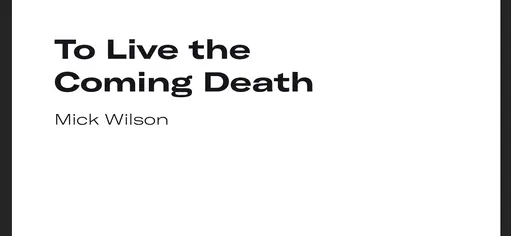
with a new introduction by Mick Wilson
Author(s)
Mick Wilson
From: Propositions for Non-Fascist Living: Tentative and Urgent, Maria Hlavajova and Wietske Maas, eds. (Utrecht: BAK, basis voor actuele kunst and Cambridge, MA: MIT Press, 2019), pp. 165-179
This text was published some months before the Covid-19 pandemic began to produce a massive death toll, which has contributed to the ignition of mass political resistance. The distribution of the chances to live or die, reckoned along local and global axes, has been daily iterated in graphs, charts, percentages, and logarithmic scales. The body count has functioned as the driver of news cycles and as an affective horror-entertainment spectacle out of which to fabricate imaginaries of safety. The body count has also operated as a powerful means to index the relative success and failure of various states and powers. Against the debasement and refusals of scientific discourses by authoritarian populists in several different parts of the world, the body count has seemed rhetorically potent as a “naked truth.” Even when counting techniques are a matter of contestation, the possibility of the unassailable pristine integer epitomizing the totality of the sick and the dead has retained a powerful hold. The disproportionate impact of the pandemic on racialized and impoverished bodies has again been used as evidence of structural racisms and systemic inequities, as if what was lacked was evidence.
However, it may also be that for the first time a widespread de-naturalization of these systemic inequities has gained wide traction within global circuits of communication. In place of the capitalist Christian evangelical’s “for the poor you will always have with you in the land,” there is now the consistent assertion that the distribution of impoverished, devalued, and unlivable life and death is the logic and achievement of specific humans, not of nature or of gods or of a virus. This text—which is about the tensions between counting the dead, the racialized logics of which deaths count, and how the dead may come to count differently—was a first attempt to consider the potency, and also the risks and the limitations of the body count as a tactic of speaking quantity to power. The further development of this thinking, which I am currently working on, will be to give full consideration as to how the dead may count otherwise within the assemblies of the living.
– Mick Wilson, 8-7-2020
To Live the Coming Death
The essay “To Live the Coming Death” by Mick Wilson appears in Propositions for Non-Fascist Living: Tentative and Urgent, Maria Hlavajova and Wietske Maas, eds. (Utrecht: BAK, basis voor actuele kunst and Cambridge, MA: MIT Press, 2019, pp. 165-179), the first volume of BAK’s BASICS series, available here via MIT Press. A second volume to the series titled Deserting from the Culture Wars is forthcoming October 2020, available for pre-order here via MIT Press.
Counting the Dead
The body count is a calculation of destruction. It announces itself with authority and circulates prominently in global networks of communication. The enumeration of the dead— whether of a school shooting or a suicide bombing, of a plane crash or a drone strike, of a refugee boat sinking or a war induced famine, of a mudslide or a forest fire—indexes the catastrophic event. It provides, variously, a metric of terror, despair, depravity, or loss. It is not a sufficient or consistent metric, as the scale and relevance of violent atrocity, environmental disaster, and human loss are modulated for different media audiences with respect to racialized, gendered, and otherwise “marked” or “unmarked” bodies.
The body count is contested. When brought to acknowledge their murders, those state actors who perpetuate violent atrocities will most often invent numbers of incident fatalities lower than those given by they who are targeted or they who seek solidarity. A project such as the Iraq Body Count (IBC) indicates the ways in which counting the dead is understood as a politically salient act. The IBC records the violent deaths that have resulted from the 2003 military intervention in Iraq, insisting that the “record of a war’s casualties must be made public.” Declaring that “violent deaths are war’s first and most unambiguous lethal outcome,” the IBC reasons that “the systematic recording of civilian deaths is neglected, when it should be a priority.” 1The counting of the dead in state violence against racialized and occupied populations has been a fundamental engine of contemporary political mobilizations as diverse as Black Lives Matter and the global movement for Boycott, Divestment, and Sanctions against Israel.
The counting of the dead, and the contestation of the results have become an essential dimension of the depiction and the denial of genocide. This is manifest in a wide range of atrocity calculations: from the Ottoman Empire’s genocide of one-and-a-half million Armenians; the Nazi extermination of six million Jews; 2 the British Empire’s famine that struck almost four million Bengalis in 1943; the Rwandan genocide of one million Tutsi in 1994; the death of two to seven million people in 1930s Ukraine under Stalin; to the contemporary destruction of a half million Western Papuans by the Indonesian state and its agents of expropriation and occupation since 1963.
This counting of the dead extends beyond the eventual atrocity or the accomplished historical catastrophe. The number of the dead is projected in estimates of climate change impact, of austerity measures, of grinding poverty, of structural violence, and of myriad other gross inequities and systemic horrors that constitute the contemporary world. This grim reckoning typically makes a tally of the human dead, even where these dead have been casually exposed to death precisely because they are bodies designated, with assured conviction, as less human, subhuman, or inhuman. The enumeration of dead human beings seems everywhere the common denominator through which human violence and “natural” disasters should be accounted.
Accounts of Human and Non-Human Death
The anti-colonial revolutionary intellectual Frantz Fanon warned long ago of the empire of insouciant violence founded upon talk of the human: “Europe where they are never done talking of Man, yet murder men everywhere they find them.” 3 For Fanon, when one searches for the human “in the technique and the style of European thought,” one sees only a succession of negations of the human and “an avalanche of murders.” The counting of the dead, as with the census of the living, is of course a central technique within that great European project of biopolitics and the management of populations, identified in the historico-philosophical analyses of Michel Foucault. Enlightened state husbandry and care for the life of the populations have long since grown to become the earnest engines of “vital massacres” that shape the dispossessions, the famines, and the genocides that compose colonial modernity. 4
The poet-philosopher Édouard Glissant proposes a different project of care and a different politics of thinking when he begins Poetics of Relation (1990) by noting that the “only written thing on slave ships was the account book listing the exchange value of slaves.” 5 He disabuses his reader of the arithmetic of atrocity when he writes: “Over the course of more than two centuries, twenty, thirty million people deported. Worn down, in a debasement more eternal than apocalypse. But that is nothing yet.” 6 The seemingly casual slippage, from twenty million to thirty million victims in the count of the Atlantic slave trade, operates not out of indifference to the scale of destruction and the immiseration of human life. It acts instead as an interruption to the presumptive capture of the enslaved in the flimsy digits of the accountant’s grasp. Ambiguation of these fatal numbers discloses the impoverishment of an imaginary that would aggregate all this horror in one pristine integer. This imaginary belongs to those who, in their confident arithmetic, would hope to fathom the open rip in history gouged out in the waters of the Black Atlantic. Those who seize upon whole numbers in a complacent historical reckoning of these broken worlds, these continents of wreckage, these white abysses.
In her poetry cycle Zong! (2008), M. NourbeSe Philip closely reads the slaver’s ledger that Glissant invokes. Zong was the name of the infamous ship from which slaves, being transported from West Africa to Jamaica in 1781, were jettisoned and massacred so that their insurance value could be claimed. NourbeSe Philip writes about her research process:
I receive a copy of a sales book kept by one Thomas Case, an agent in Jamaica who did business with the owners of the Zong. It is typical of the records kept at that time: Purchasers are identified while Africans are reduced to the stark description of “negroe man,” [sic] “negroe woman,” or, more frequently, “ditto man,” “ditto woman.” … This description leaves me shaken—I want to weep. 7
NourbeSe Philip’s text registers an affective density that this banal accountancy disavows. “The African men, women, and children on board the Zong were stripped of all specificity, including their names. Their financial value, however, was recorded and preserved for insurance purposes, each being valued at 30 pounds sterling.” 8 In the legal battle that ensued over the insurance claims, the Solicitor General of England, John Lee, argued vigorously that the killings were not a question of murder but of property and insurance. 9 This reduction of man, woman, and child to commodity is the social death that seeks to effect an ungrievable life.
In a different reading, philosopher Denise Ferreira da Silva calls attention to the material persistence of both the dead and the living slave body as matter insinuated and dispersed into the historical present. Ferreira da Silva asserts that the vital space of the Atlantic
…is constituted by these dead people who did not complete the voyage between the West African coast and the Americas or Europe. And not only the dead ones: those who completed the crossing to be sold as slaves also left traces of their bodies, as sweat, blood, urine, spit in the waters along the way. Residence time (the measure of duration for the persistence of different materials in the ocean) reminds us of that. Residence time also tells us that traces of the flesh of the dead slaves remains here/now as part of the composition that is the Atlantic Ocean. 10
For Ferreira da Silva, it is in the reduction to disaggregated matter of a dispersed “object” body that an affective agency, in excess of the banal accountancy of the ship’s ledger, is registered. Across NourbeSe Philip’s and Ferreira da Silva’s readings there is an unfinished and rebounding movement between the human dead as the singular named or unnamed beings denied humanity and the human dead as the de-singularized material human remains that persist in the ocean and in the food chain, and so co-constitute, together with the living generation, the historical present.
Some have announced that it is only the human that dies, and that all other life merely perishes. 11 But others have revoked this closure of the community of the dead. There appears to be a new conviction among scholars that more than the human, and other than the human, dies. In this expanded and inclusive community of the dead, one learns the new and escalating accountancies of non-human death that bravely measure the extinction of species and the destruction of biodiversity. Accompanying these new measures, some construct the new crime of ecocide, to be placed alongside genocide and politicide. 12 Nevertheless, juridical longings, however, chase after the arithmetics of atrocity in the boundless confidence that the whole world is still given over to some humans for them to demarcate, enumerate, and legislate.
In this expanded accountancy of catastrophe, the projections of the body count seem to attain to a new exponential register of the biopolitical, as the population of populations becomes the object of the coming power. The imaginary of this grand accountancy allows that some humans have arrogated to themselves the right and the capacity to manage all life on the planet. In the concluding section of History of Sexuality Volume I, Foucault already announces the way biopolitics and its management of the population turns into a politics of death, a thanatopolitics, that liquidates the very life it claims to protect. 13 Given the grandly murderous schemes of historical biopolitics, what limitless murders could be commissioned in the name of a planetary caring for all of life, for all that lives, and for all that has yet to live?
There is here a doubling of the double bind. If the dead, all those designated for the earliest of graves are not counted, how will anyone comprehend the enormity of the crime? And if the dead are counted, how will the calculation that balances the death of a few millions here and there against the life of all living things and all that has yet to live be refused? If mass extinction, not attended to the enormity and vast scale of human-caused 14 environmental degradation, to climate change, and population destruction are not attended to, that equates to complicity in the willful destruction of worlds. If these images of mass destruction and the threat of myriad species’ death are politically mobilized, however, then, those powers are augmented (already in much-bloodied evidence) that have planned the exposure of vast populations to destruction in the name of preserving other lives—great powers that may now operate in the name of preserving the very possibility of life itself.
If one holds to talk of the value of a human life, so deeply embedded within the liberal dogma of possessive individualism, then one simply continues to work out the horrors of the ever-mobile human exclusion that Fanon so precisely named. If, on the other hand, one abandons talk of the human, one seems to move inexorably toward condoning the destruction of human populations in the name of the greater good of all that may yet live.
A grand demographic arithmetic is being rehearsed in the wings, which says, perhaps, that the lesser of some great losses must be incurred in order to save anything. It practices its lines: “perhaps the thirty million to be displaced around the Bay of Bengal must be let go to the coming flood”; “perhaps the twenty million in the European Union’s sub-Saharan holding pen must be forfeit to the coming storm”; “perhaps it is now time for maturity and for difficult decisions as we cannot all hope to survive”; “perhaps the mercy will be to make the death easy and calm where possible”; “perhaps the mercy will be to not give them hope.” But that is nothing yet.
Beyond the Accountant’s Share
The economic and territorial rationalities of enslavement, of genocide, and of ecological wreckage that are accounted within all these ledgers of colonial modernity, that are routinized for the quarterly return, still do not in themselves give that sweet taste nor that righteous enthusiasm for others’ pain. What in these numbers can explain the passioned labor of hacking through living bone; the joyful community gathered at the foot of the lynching tree; the twitching pleasures at the joystick of the drone; the delighted intimacy of torture; the exquisite attunement of inattentive care in the daily husbandry of unlivable lives; the infinite imagination teasing out the fine technicalities of terror; the precise decorum orchestrating vast terrains of living death stretched out, out there just beyond the sacred border; and all the frenzied ecstasies of the kill? In service of what logic, to what grammar, may all the bloodlusts yearning for more be assigned, far beyond the rationale of population management or the reward of profit?
Philosopher and political theorist Achille Mbembe has introduced the concept of necropolitics, the subjugation of life to the power of death, to name a grammar of power beyond the management of the life of populations; a power first constituted in the colonial projects of the European powers and their slave plantations. 15Necropolitics speaks to the way that sovereign power over life in the colonial scene (and in mutiplicitous zones of exception and cultures of terror beyond law, in death-worlds such as Gaza, a central exemplar for Mbembe) produces both a pervasive violent everyday of living death and an excessive violence of absolute destruction; a furious systemic overkill. These are dimensions of the exercise of the power of death over “life” that are not adequately addressed by the theme of biopolitics. He identifies this production of death within a framework of perceived perpetual threat—the need for endless war—as a key paradigm of sovereign power determined in the European colonial project. This is a mode of sovereignty that seizes upon “life” as its object through an orchestration of terror and death.
The anthropologist Michael Taussig, in his careful unpacking of the early twentieth-century British Consul Roger Casement’s Putumayo Report, 16 has produced an analysis of a micro-culture of necropower that operates in excess of the accountant’s share. 17 The Putumayo wild rubber boom of the early twentieth century is typical of the biopolitical logic of colonial expropriation, whereby the life of the native population is by turns mobilized and liquidated in the service of the economy of the colony and of the shareholders in the metropolitan centers of empire. The demand for cheap labor to enable the wild rubber harvest generated a logic of violence and terror perpetrated upon the peoples of the Putumayo by the white colonial adventurers. As one commentator describes, “the natives are exposed to attack without protection of the law by the whites, who hunt and persecute them like animals of the jungle, recognizing as their only value the sum represented by their sale.” 18 The harvesting of wild rubber required a system of terror to enforce the debt servitude that enslaved the indigenous people of the Putumayo in the absence of a viable wage labor system: “an estimate was made that every ton of rubber from the Amazon Valley cost two human lives … the methods of the Putumayo must have quadrupled it. If the native rubber-gatherer were treated as an ordinary laborer and paid a due wage, it is safe to say that it would not pay to gather wild rubber at all, or only by increasing its price in the world’s market very considerably.” 19
But, as Casement’s famous report indicates, an economy of terror began to displace this economy of rubber, enforced labor, and debt servitude. Casement and—reading in his colonial tracks—Taussig itemize a hellish accountancy of misery, injury, torture, cruelty, terror, and murder perpetuated by the rubber-station men upon the native peoples, ostensibly to secure the necessary level of rubber harvests. Taussig then observes that in this system of terror the overseers and executioners “had lost all sight or sense of rubber-gathering—they were simply beasts of prey who lived upon the Indians and delighted in shedding their blood.” 20 Quite clearly, the regime of violence and death operated by the rubber-station managers was eroding company profit, compromising the ledger’s balance.
Taussig argues that while this terror had some claim to be “functional to the needs of the labor system,” this does not explain “the most significant contradictions,” especially “that the slaughter of this precious labor was on a scale vast beyond belief” and ultimately contrary to the needs of the enterprise. 21
In Putumayo, the subjection of life to the power of death is not a matter of the sovereign right to put to death, nor of the letting die that is the thanatopolitical face of biopower, but rather it is the emergence of a different moral economy of violence and terror. 22 This warrants Mbembe’s proposition as to the inadequacy of biopolitics as analytic for the rationality of power in the death-world and the need for another term beyond biopolitics/thanatopolitics to name this grammar of power that produces a pervasive culture of terror and a condition of living death. Applied in this concrete instance, the descriptive and analytical value of necropolitics is moved from the theme of sovereignty within political ontology to the theme of the moral economy of violence within a specific historical project of slaughter.
The Moral Economy of Violence to Come
In the current historical juncture an intensified necropower must be anticipated that predicates itself upon the vastness of the coming death and the risk to the life of life itself: the sixth extinction; ecological collapse; the massive displacement and destruction of populations through climate catastrophe. The coming death engenders the conditions for a necropolitical imaginary that will produce death-worlds rendered countable and thinkable by death counts, which will thereby render them all the more incomprehensible. What is being witnessed is the emergence of a global moral economy of violence that modifies and recalibrates the racist and genocidal logics of colonial-modernity with which it is substantially continuous.
There is a generation that comes and says, “We did not author the carbon economy, we did not generate this ecological degradation; we inherited a despoiled world. And we have taken our historical responsibility to address the errors of the past, and redeem what of life on the planet there is that can be redeemed”. This generational disavowal, taken together with a claim to responsible acceptance of the inherited burden, will provide the conditions of possibility for the new moral economy of violence.
The greatest challenge for this emergent ordering of legitimate violence will be the question of how to regulate the historically-demonstrated pleasures and ecstasies of violence where their playing fields are opened up. For even the stewardship of life and the management of the population of populations will have to give some account of its own operational practices. The acceptability to many of drowning refugees, keeping babies in cages, and the relentless attrition of occupied populations in the name of security and containment of threat are but today’s small samplers of the kinds of horror that may yet come as the scale of imminent threat is vastly expanded. To be given the semblance of legitimacy, these violences must be devoid of pleasure. They must be borne with regret and disdain for their dismal but overwhelming necessity. The claim that one is not the author of a crime, merely the inheritor of its consequences, means that one must distance oneself from the pleasures and the ecstasies of the crime’s avenging violence.
This is the challenge of the moral economy of violence that belongs to the death to come: How does the coming power expose vast populations to an exclusion-unto-death without being seen as the orchestrator of a zone of living hell, a place of delight for predators? How does the coming power constitute itself as the reluctant architect of spaces of expedient and humane death in the name of the greater good of all that has yet to live? We may also anticipate that the well-worn habits of counting the dead will play their part in this coming pragmatics of violence. It may be precisely that as the death count rises, widespread reconciliation to the difficulties of responsible management of the population of populations will ease along and follow apace. No work upon the self will answer the question of how to live the coming death.
What, then, are the ways in which this coming death may be lived otherwise, may be resisted? Two propositions for living against its apocalyptic logic could be these: to collectively re-imagine death as something that cannot be reduced simply to non-existence; and to re-imagine forms of political community that bind the living and the dead within resolutely materialist terms. If the dead are counted as beings among the living—not as revenants or ghosts, but as beings in disjunctive co-belonging with the living—it may just be possible for the dead to count, and not simply be counted, against the moral economy of violence that is premised upon the coming death.
1 “Rationale,” Iraq Body Count, www.iraqbodycount.org
2 It is particularly notable how the figure “six million” has become a cypher specifically of the Jewish victims of the Nazi atrocities, while the target populations of Nazi genocide also included Roma people, the disabled, and homosexuals. See “Holocaust Facts: Where Does the Figure of 6 Million Victims Come From?,” Haaretz, 1 May 2019, www.haaretz.com
3 Frantz Fanon, The Wretched of the Earth, trans. Constance Farrington (New York: Grove Press, 1963), p.311.
4 Michel Foucault, The Will to Knowledge: The History of Sexuality Volume 1, trans. Robert Hurley (London: Penguin, 1990), p. 137.
5 Édouard Glissant, Poetics of Relation, trans. Betsy Wing (Ann Arbor: University of Michigan Press, 2010), p. 5.
6 Ibid., p. 6.
7 M. NourbeSe Philip, Zong! (Middletown: Wesleyan University Press, 2011), p. 194.
8 Ibid.
9 “What is this claim that human people have been thrown overboard? This is a case of chattels or goods. Blacks are goods and property; it is madness to accuse these well-serving honourable men of murder. They acted out of necessity and in the most appropriate manner for the cause. The late Captain Collingwood acted in the interest of his ship to protect the safety of his crew. To question the judgement of an experienced well-travelled captain held in the highest regard is one of folly, especially when talking of slaves. The case is the same as if wood had been thrown overboard.” See “The Case,” The Middle Passage, zongmiddlepassage.weebly.com
10 “Arjuna Neuman & Denise Ferreira da Silva, ‘Serpent Rain.’ Introduced by Margarida Mendes,” Vdrome, 17–30 April 2018, www.vdrome.org
11 “The mortals are the human beings. They are called mortals because they can die. To die means to be capable of death as death. Only man dies.” Martin Heidegger, “Building, Dwelling, Thinking,” in Poetry, Language, Thought, trans. Albert Hofstadter (New York: Harper Collins, 1971), p. 148.
12 “Relevant International Crime History,” Ecocide Law, eradicatingeco¬cide.com/the-law/history/.
13 Foucault, The Will to Knowledge, pp. 135–139.
14 The term “human-caused” is employed here in preference to “anthropogenic” because it is intended to signal the agency of “some” humans rather than the species impact of “all” humans. See Françoise Vergès, “Racial Capitalopocene,” in Futures of Black Radicalism, Gaye Theresa Johnson and Alex Lubin, eds. (London: Verso, 2017).
15 Achille Mbembe, “Necropolitics,” Public Culture, vol. 15, no. 1 (Winter 2003), pp. 11–40.
16 In July 1910, Sir Edward Grey, head of the British Foreign Service, placed Roger Casement in a commission going to investigate reports of atrocities on the Putumayo River of the upper Amazon. Casement’s five Putumayo reports, prepared for Grey, are contained within the parliamentary papers Correspondence Respecting the Treatment of British Colonial Subjects and Native Indians in the Putumayo District (1912). A final version of the report was published by the House of Commons on 13 July 1913.
17 Michael Taussig, “Culture of Terror—Space of Death. Roger Casement’s Putumayo Report and the Explanation of Torture,” Comparative Studies in Society and History, vol. 26, no. 3 (July 1984), pp. 467–497.
18 W. E. Hardenburg, The Putumayo: The Devil’s Paradise (London: T. Fisher Unwin, 1912), p. 23.
19 Ibid., pp. 46–47.
20 Taussig, “Culture of Terror,” p. 478.
21 Ibid., p. 479.
22 The term “moral economy,” first given explicit formulation by English historian E.P. Thompson, has been given a more generalized formulation by French anthropologist and sociologist Didier Fassin, who takes it to be “the production, distribution, circulation, and use of moral sentiments, emotions and values, and norms and obligations in social space.” Didier Fassin, “Les économies morales revisitées,” Annales. Histoire, Sciences Sociales, vol. 64, no. 6, (June 2009), pp. 1237–1266.
More in this edition
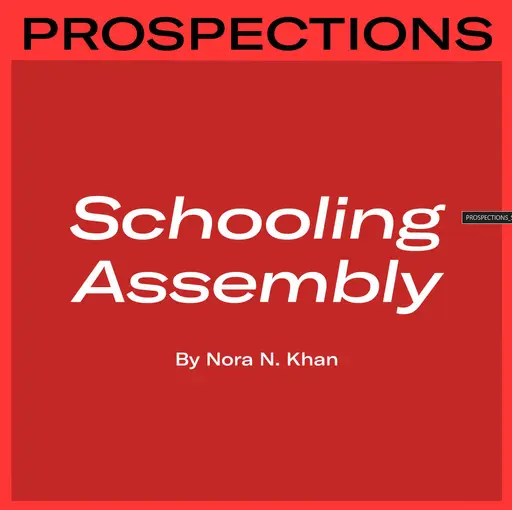
“Schooling Assembly” by Nora N. Khan traverses a year of pandemic teaching, in which faculty and students have witnessed widening cracks in the university system and its human opportunity cost calculations, and have faced new challenges in asserting creative and collective autonomies.
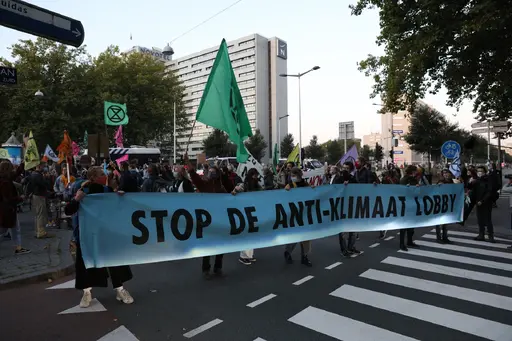
Extinction Rebellion (XR) entered the spotlight in late 2018 with a call for mass disruptions, followed by a first wave of actions which saw thousands come together to block major bridges in London.

This diagram by artist Jeanne van Heeswijk depicts the story of Freehouse Radicalizing the Local, a project focusing on the struggle for the right to live well in the Afrikaanderwijk neighborhood of Rotterdam.
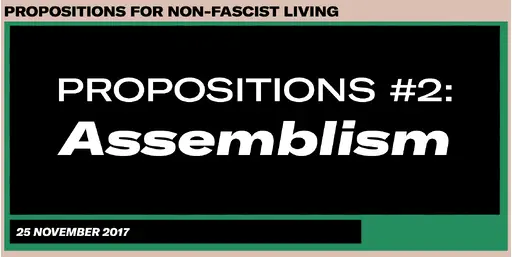
The gathering Third Assembly: After the Assembly took place as part of the daylong program Propositions #2: Assemblism, convened by BAK and artist Jonas Staal on 27 November 2017.

From: Propositions for Non-Fascist Living: Tentative and Urgent, Maria Hlavajova and Wietske Maas, eds. (Utrecht: BAK, basis voor actuele kunst and Cambridge, MA: MIT Press, 2019), pp. 165-179
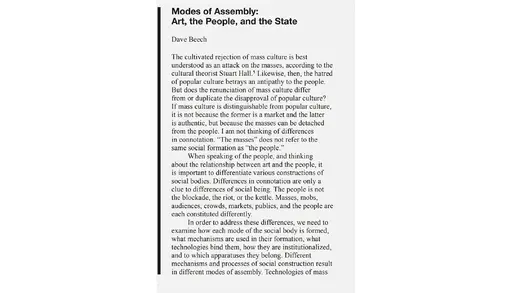
From: FORMER WEST: Art and the Contemporary After 1989, Maria Hlavajova and Simon Sheikh, eds. (Utrecht: BAK, basis voor actuele kunst and Cambridge, MA: MIT Press, 2016), pp. 559-569
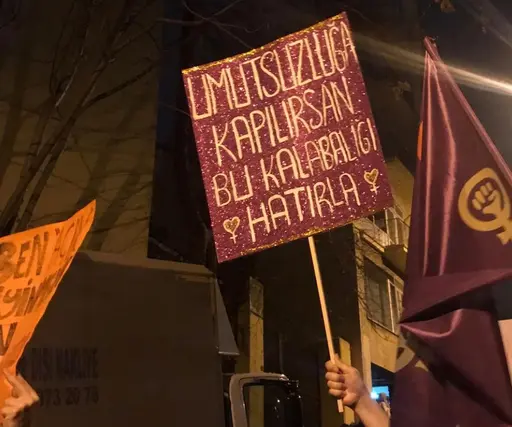
"We were in the streets for the Feminist Night March on 8 March, exactly three days before the first Covid-19 case was officially declared in Turkey..." Read the translation of an essay originally published in Turkish on 1+1 Forum, 30.04.2020.